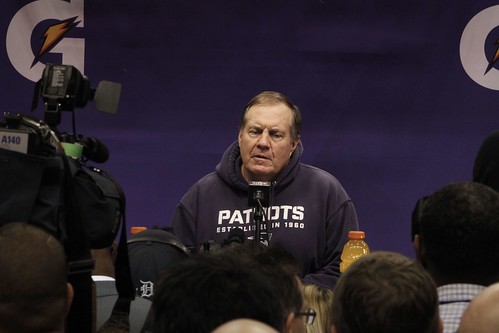The End of the Bill Belichick Hoodie Era
Belichick #Belichick

In all the words currently being written about the end of the Bill Belichick era in Boston — or, technically, the Boston suburbs — which reportedly finally came to a close on Jan. 11 after weeks of speculation, the end of the N.F.L. season and the Patriots’ dismal loss to the Jets, the one that sticks in my mind is “hoodie.”
More than anyone except perhaps Mark Zuckerberg, Boston’s famous football coach has become synonymous with that particular garment. It is “an inseparable part of his legacy,” according to Bleacher Report. His “trademark,” wrote Sports Illustrated. “Iconic,” crowed Buzzfeed. For decades the hoodie helped burnish the Belichick legend, but recently it has begun to seem part of the problem: less a symbol of his coaching genius than, perhaps, a sign of his obsolescence.
For most of his 24 years with the Patriots, the sweatshirt has been Mr. Belichick’s garment of choice for game day. And not just any old sweatshirt, but a particularly nondescript, schlubby blue or gray sweatshirt, often with the sleeves lopped off in a seemingly random way somewhere between the elbow and the shoulder, and layered over another shirt. Sometimes it was paired with flip-flops. The majority of that time, when he was leading the team to its six Super Bowl wins, the sweatshirt seemed to symbolize Mr. Belichick’s singularity: his ornery refusal to be anything but himself or follow any vision but his own; his gruff, blue-collar fighting spirit; his consistency; his refusal to give up — not the game and not his favorite wardrobe item.
It got him named to various “best-dressed” lists with the sort of affectionate irony traditionally lavished on irascible but beloved uncles, and led to a “Bill Belichick raglan pullover hoodie” being sold in the N.F.L. merch shop. His commitment to the garment inspired one football prognosticator to create a “hoodie tracker,” and it has been the subject of Super Bowl betting. Mr. Belichick even presented a hoodie to President George W. Bush on a visit to the White House.
The origin story of Mr. Belichick and the sweatshirts is part of his mystique. He first appeared in a gray hoodie in 2003. (Before that he often wore windbreakers on the field.) As the tale goes, he adopted the hoodies after the N.F.L. made a deal with Reebok (now Nike) that included coaches, meaning that they were forbidden to wear the sort of tailored suits that once distinguished men like Tom Landry, Hank Stram, Blanton Collier and even Vince Lombardi. Instead they had to wear team gear, becoming a walking billboard for the sponsor.
As a form of protest against the selling of the sport, it was said, Mr. Belichick chose to wear the most aggressively unfashionable garment he could find within the dress code. (He had, after all, worn a suit in various appearances beforehand, not to mention on the cover of Nantucket Magazine, and cleans up perfectly well when he wants to.)
Whether or not the middle finger-to-the-corporate-overlords narrative was true, the attitude it reflected fed the Belichick ethos in a way that worked in the coach’s favor, as even he must have realized, since he never refuted the idea (even when asked about it directly). Instead, Mr. Belichick somewhat coyly sidestepped the question, telling Yahoo columnist Dan Wetzel that he liked sweatshirts because they were “comfortable” and he could “carry stuff in the pouch.” As for cutting the sleeves, it was because his arms were “too short” and all that fabric was getting in the way.
Fair enough, except that in framing Mr. Belichick as a man of principle focused purely on his job, rather than fashion, the responses revealed just how aware of the power of fashion he actually is. Being worst dressed is just as much a choice and a statement as being best dressed. And therein lies the rub.
Indeed, the Zuckerberg comparison may not be as far-fetched as it sounds. The old mythology of Silicon Valley was built in part on the image of tech prodigies untethered from the petty concerns of the everyday — jackets and ties — only to suffer from periodic backlashes when the untethered bit seemed to lead to psychological abuse or financial crimes. Similarly, it turns out, the Belichick image may have contained within it the seeds of its own destruction.
Over the last few seasons, football has followed sports like basketball and soccer into the world of fashion, with players — Tom Brady and Russell Wilson, both of whom have their own lines, as well as current athletes like Davon Godchaux, Joe Burrow and (ahem) Travis Kelce, who seem to be headed that way — increasingly aware of their own potential. Not Mr. Belichick, however, and the contrast has made his insistence on wearing the same old same old seem more like a rut; an example of what started to look like a stubborn refusal to change not just his wardrobe, but with the times.